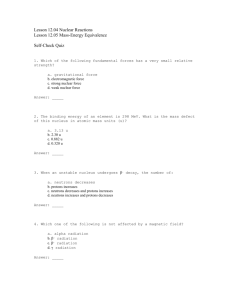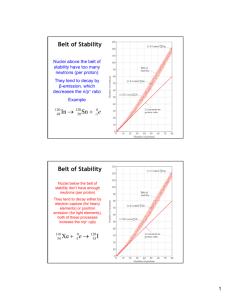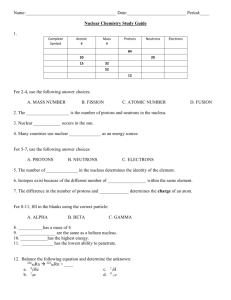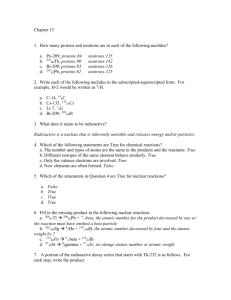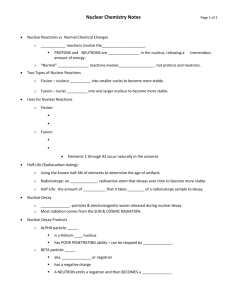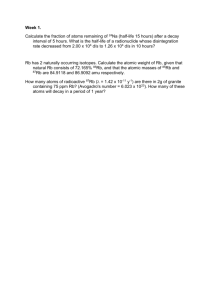Nuclear Chemistry powerpoint
advertisement
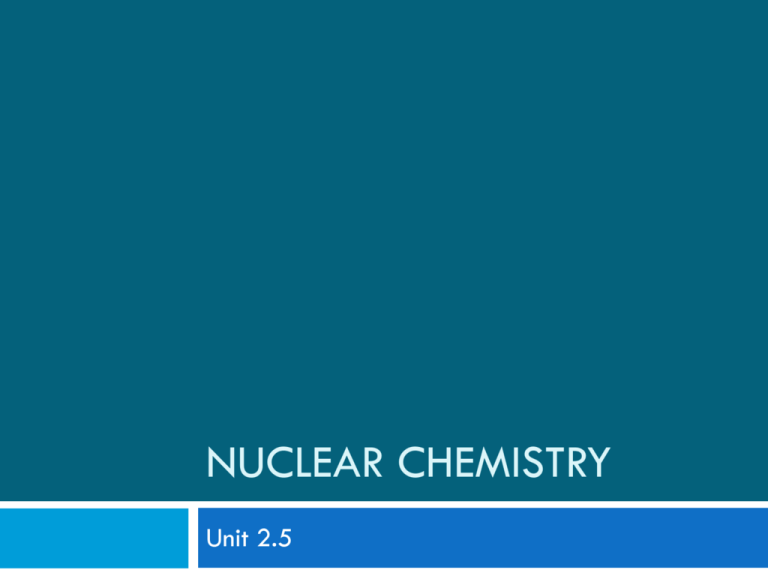
NUCLEAR CHEMISTRY Unit 2.5 Introduction to Nuclear Chemistry Nuclear chemistry is the study of the structure of and the they undergo. Chemical vs. Nuclear Reactions Chemical Reactions Nuclear Reactions Bonds are broken Nuclei emit particles and/or rays Chemical vs. Nuclear Reactions Chemical Reactions Nuclear Reactions Bonds are broken Nuclei emit particles and/or rays Atoms are rearranged Atoms changed into atoms of another element Chemical vs. Nuclear Reactions Chemical Reactions Nuclear Reactions Bonds are broken Nuclei emit particles and/or rays Atoms may be rearranged Atoms changed to atoms of different element Involve valence electrons Involve protons, neutrons, and/or electrons Chemical vs. Nuclear Reactions Chemical Reactions Nuclear Reactions Bonds are broken Nuclei emit particles and/or rays Atoms are rearranged Atoms change into atoms of different element Involve valence electrons Involve protons, neutrons, and/or electrons Small energy changes Large energy changes Chemical vs. Nuclear Reactions Chemical Reactions Nuclear Reactions Bonds are broken Nuclei emit particles and/or rays Atoms are rearranged Atoms change into atoms of different element Involve valence electrons Involve protons, neutrons, and/or electrons Small energy changes Large energy changes Reaction rate can be changed. Reaction rate cannot be changed The Discovery of Radioactivity (1895 – 1898): found that invisible rays were emitted when electrons hit the surface of a fluorosent screen (discovered x-rays) Becquerel accidently discovered that phosphorescent rock produced spots on photographic plates The Discovery of Radioactivity (1895 – 1898): isolated the components ( emitting the rays atoms) – process by which atoms give off particles – the penetrating rays and by a radioactive source The Discovery of Radioactivity (1895 – 1898): Marie Curie, continued identified 2 new elements, and on the basis of their radioactivity These findings theory of indivisible atoms. Dalton’s The Discovery of Radioactivity (1895 – 1898): – atoms of the same element with different numbers of – isotopes of atoms with unstable nuclei (too many or too few neutrons) – when unstable nuclei lose energy by emitting to become more Alpha radiation Composition – Alpha particles, same as helium nuclei 4 Symbol – Helium nuclei, 2He, α Charge – 2+ Mass (amu) – 4 Approximate energy – 5 MeV Penetrating power – low (0.05 mm body tissue) Shielding – paper, clothing Beta radiation Composition – Beta particles, same as an electron Symbol – e-, 0-1β Charge – 1Mass (amu) – 1/1837 (practically 0) Approximate energy – 0.05 – 1 MeV Penetrating power – moderate (4 mm body tissue) Shielding – metal foil Gamma radiation Composition – High-energy electromagnetic radiation Symbol – ooγ Charge – 0 Mass (amu) – 0 Approximate energy – 1 MeV Penetrating power – high (penetrates body easily) Shielding – lead, concrete Review of Atomic Structure Nucleus Electron Cloud 99.9% of the mass 0.01% of the mass 1/10,000 the size of 9,999 times the size the atom of the nucleus Review of Atomic Structure Nucleus Electron Cloud 99.9% of the mass 1/10,000 the size of the atom 0.01% of the mass, 9,999 times the size of the nucleus Protons (p+) and neutrons (n0) Electrons (e-) Review of Atomic Structure Nucleus Electrons 99.9% of the mass 1/10,000 the size of the atom 0.01% of the mass, 9,999 times the size of the nucleus Protons (p+) and neutrons (n0) Electrons (e-) Positively charged Negatively charged Review of Atomic Structure Nucleus Electrons 99.9% of the mass 1/10,000 the size of the atom 0.01% of the mass, 9,999 times the size of the nucleus Protons (p+) and neutrons (n0) Electrons (e-) Positively charged Negatively charged Strong nuclear force Weak electrostatic (holds the protons force (between together) electrons and nucleus Chemical Symbols A chemical symbol looks like… 14 6 C To find the number of from the p+ = e- = atomic # , subtract the Nuclear Stability Isotope is completely stable if the nucleus will spontaneously . Elements with atomic #s to are . ratio of protons:neutrons ( ) Example: Carbon – 12 has protons and neutrons Nuclear Stability Elements with atomic #s to are . ratio of protons:neutrons (p+ : n0) Example: Mercury – 200 has protons and neutrons Nuclear Stability Elements with atomic #s and . Examples: and are Alpha Decay Alpha decay – emission of an alpha particle ( ), denoted by the symbol 4 , because an α has 2 2 protons and 2 neutrons, just like the He nucleus. Charge is because of the 2 . Alpha decay causes the number to decrease by and the number to decrease by . determines the element. All nuclear equations are . Alpha Decay Example 1: Write the nuclear equation for the radioactive decay of polonium – 210 by alpha emission. Step 4: 1: Determine 2: 3: Draw the Write the arrow. element alpha the other particle. that product you are (ensuring starting with. everything is balanced). Mass # Atomic # Alpha Decay Example 2: Write the nuclear equation for the radioactive decay of radium – 226 by alpha emission. Step 4: 1: Determine 2: 3: Draw the Write the arrow. element alpha the other particle. that product you are (ensuring starting with. everything is balanced). Mass # Atomic # Beta decay Beta decay – emission of a beta particle ( ), a fast moving , denoted by the symbol or -10 . β has insignificant mass ( ) and the charge is because it’s an . Beta decay causes change in number and causes the number to increase by . A neutron is converted to a proton and a beta particle. Beta Decay Example 1: Write the nuclear equation for the radioactive decay of carbon – 14 by beta emission. Step 4: 1: Determine 2: 3: Draw the Write the arrow. element beta the other particle. that product you are (ensuring starting with. everything is balanced). Mass # Atomic # Beta Decay Example 2: Write the nuclear equation for the radioactive decay of zirconium – 97 by beta decay. Step 4: 1: Determine 2: 3: Draw the Write the arrow. element beta the other particle. that product you are (ensuring starting with. everything is balanced). Mass # Atomic # Gamma decay Gamma rays – high-energy radiation, denoted by the symbol . γ has no mass ( ) and no charge ( ). Thus, it causes change in or numbers. Gamma rays almost accompany alpha and beta radiation. However, since there is effect on mass number or atomic number, they are usually from nuclear equations. Transmutation the of an atom of one element to an atom of a different element. Radioactive decay is one way that this occurs! Review Type of Radioactive Decay Alpha Beta Gamma Particle Emitted 4 2 He 0 -1e α β γ Change in Change in Mass # Atomic # -4 0 0 -2 +1 0 Half-Life is the required for of a radioisotope’s nuclei to decay into its products. For any radioisotope, # of ½ lives % Remaining 0 1 2 3 100% 50% 25% 12.5% 4 5 6 6.25% 3.125% 1.5625% Half-Life Half-Life 100 90 80 % Remaining 70 60 50 40 30 20 10 0 0 1 2 3 # of Half-Lives 4 5 6 7 Half-Life For example, suppose you have 10.0 grams of strontium – 90, which has a half life of 29 years. How much will be remaining after x number of # of ½ lives Time (Years) Amount years? Remaining (g) You can use a table: 0 1 2 3 4 0 29 58 87 116 10 5 2.5 1.25 0.625 Half-Life Or an equation! Half-Life Example 1: If gallium – 68 has a half-life of 68.3 minutes, how much of a 160.0 mg sample is left after 1 half life? ________ 2 half lives? __________ 3 half lives? __________ Half-Life Example 2: Cobalt – 60, with a half-life of 5 years, is used in cancer radiation treatments. If a hospital purchases a supply of 30.0 g, how much would be left after 15 years? ______________ Half-Life Example 3: Iron-59 is used in medicine to diagnose blood circulation disorders. The half-life of iron-59 is 44.5 days. How much of a 2.000 mg sample will remain after 133.5 days? ______________ Half-Life Example 4: The half-life of polonium-218 is 3.0 minutes. If you start with 20.0 g, how long will it take before only 1.25 g remains? ______________ Half-Life Example 5: A sample initially contains 150.0 mg of radon-222. After 11.4 days, the sample contains 18.75 mg of radon-222. Calculate the half-life. Nuclear Reactions Characteristics: Isotopes of one element are isotopes of another element Contents of the amounts of into change are released Types of Nuclear Reactions decay – alpha and beta particles and gamma ray emission Nuclear - emission of a or Nuclear Fission of a nucleus - Very heavy nucleus is split into approximately fragments reaction releases several neutrons which more nuclei - If controlled, energy is released (like in ) Reaction control depends on reducing the of the neutrons (increases the reaction rate) and extra neutrons ( creases the reaction rate). Nuclear Fission - 1st controlled nuclear reaction in December 1942. 1st uncontrolled nuclear explosion occurred July 1945. - Examples – atomic bomb, current nuclear power plants Nuclear Fission Disadvantages Produces high level radioactive waste that must be stored for 10,000’s of years. Meltdown causes disasters like in Japan and Chernobyl. Advantages Zero air pollution Not a fossil fuel so doesn’t contribute to climate change Nuclear Fusion - Fusion: Combining of two nuclei - Two light nuclei combine to form a single heavier nucleus - Does not occur under standard conditions (positive nuclei repel each other) - Advantages compared to fission – No radioactive waste, inexpensive , - Disadvantages - requires large amount of energy to start, difficult to control. - Examples – energy output of stars, hydrogen bomb, future nuclear power plants Uses of Radiation Radioactive dating: Carbon–14 used to determine the age of an object that was once alive. Detection of diseases: Iodine–131 used to detect thyroid problems, technetium–99 used to detect cancerous tumors and brain disorders, phosphorus – 32 used to detect stomach cancer. Treatment of some malignant tumors (cobalt–60 and cesium–137) cancer cells are more sensitive to radiation than normal, healthy cells Uses of Radiation X-rays Radioactive tracers: used in research to tag chemicals to follow in living organisms Everyday items: thorium–232 used in lantern mantels, plutonium–238 used in long-lasting batteries for space, and americium–241 in smoke detectors.


